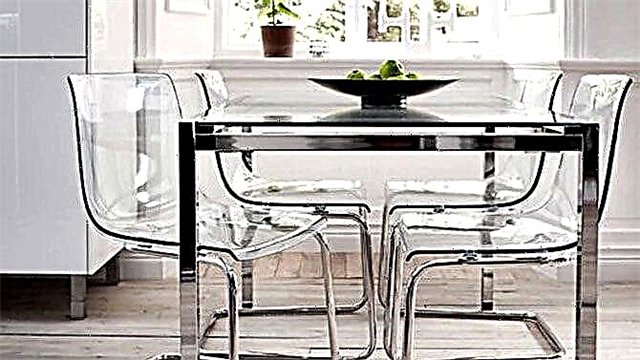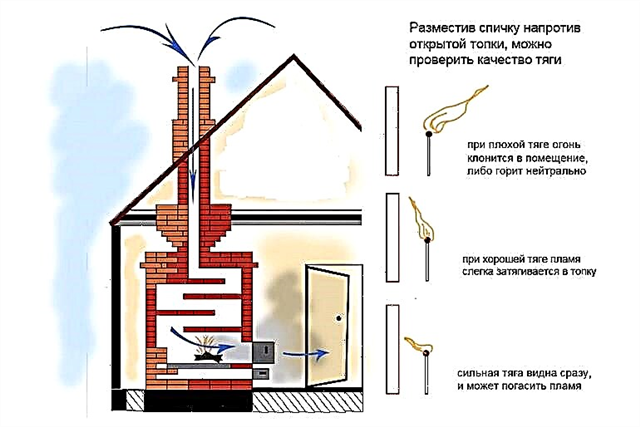The oriental bright and colorful, European-style and laconic Moroccan style attracts extraordinary originality. Immersed in its atmosphere, you can feel the pleasant and subtle aroma of spices, coffee and hookah.
Today we are once again talking about the Moroccan style. Earlier, we introduced you to its features, but now we offer you to enjoy the beauty of the now-popular green tile.
Oriental accent tile
Zelidge is a real art of painting and mosaic. It is made manually from clay. Masters paint small plates with multi-colored enamel. This is a very painstaking and delicate work, which explains the high price and exclusivity of Moroccan tiles.
It is created in the form of octagons, squares, triangles, crosses, hexagons and rhombs. Then you can create real works of art by folding a mosaic from small parts, while respecting the integrity of the composition traditional for Morocco.
The birth of Moroccan beauty
For the production of Moroccan tiles using old technology. The masters who create it have been studying this art since 8 years old. They remain students until the age of 25, when they finally receive the title of master.
Moroccan tiles are made in several stages. On the first of these, the master makes clay blanks. The second step is to dye the workpieces with organic dyes. The third stage is enamel coating of the tiles.
Next, you need to cut out small geometric figures using a special template. After that, the tile is neatly laid out on the floor down with enamel according to the previously conceived ornament. The final step is to consolidate the work using liquid clay.
Fusion of cultures
Moroccan style is a real bouquet of exotic flowers, different colors and shapes. Here, in a harmonious synthesis, Arab, European, Berber and African cultures merged. Spice, French and even Romans once brought their peppercorn to it. All this is brightly reflected on Moroccan tiles.
Intricate patterns
Another striking feature of this tile is its ornaments. As you know, in the eastern world it is not allowed to portray animals or humans. That is why Moroccan tiles are replete with floral and geometric patterns. Here you can find complex symmetrical ornaments that are subject to special mathematical algorithms and combinations of shades.
The most common of Moroccan ornaments are abstract flowers and six-pointed stars, as well as various compositions of geometric shapes.
Juicy shades
Eastern culture attracts many Europeans with its brightness, rich colors and bright accents. Colors on Moroccan tiles may include bright green, coral, yellow, deep red, and cobalt blue. They are perfectly combined with terracotta, sand and ocher shades traditional for the Moroccan style.
It is interesting to combine contrasting colors on the tile - blue and red, ultramarine and white, emerald and white.
Universal elegance
Another indisputable advantage of Moroccan tiles is its versatility. It is used for facing balconies, fireplaces, stairs, bathrooms, fountains, living rooms, kitchens and bathrooms.
You can meet such tiles even in bedrooms. It can be on the walls, and on the ceiling, and on the floor, and even on furniture. Large canvases are laid out from it, and also with its help they make small accents.
She looks spectacular in different styles. Even in the popular Scandinavian today. It is interesting that modern interiors use not only traditional zeij tile, but also stylization for it - ceramic tiles painted in the Moroccan style, wallpaper with oriental ornaments, textiles with geometric shapes inherent in Islamic culture.
What is Moroccan style?
Morocco is an amazing, mysterious country. The Moroccan style is primarily ethnic, so the interior has so many ancient elements and it is characterized by an almost complete absence of modern elements. This is a small minus of this style: it is not so easy for him to choose the appropriate furniture and decor items, it is necessary to build on the fact that eastern wealth and comfort are in the first place here.

In the Moroccan style, there are practically no restrictions on the use of colors: bold bright colors alternate with brown, pink and purple. Straight lines are often used, such as mosaic glass or triangular arches. Nowhere to go without wooden, leather and ceramic accessories.
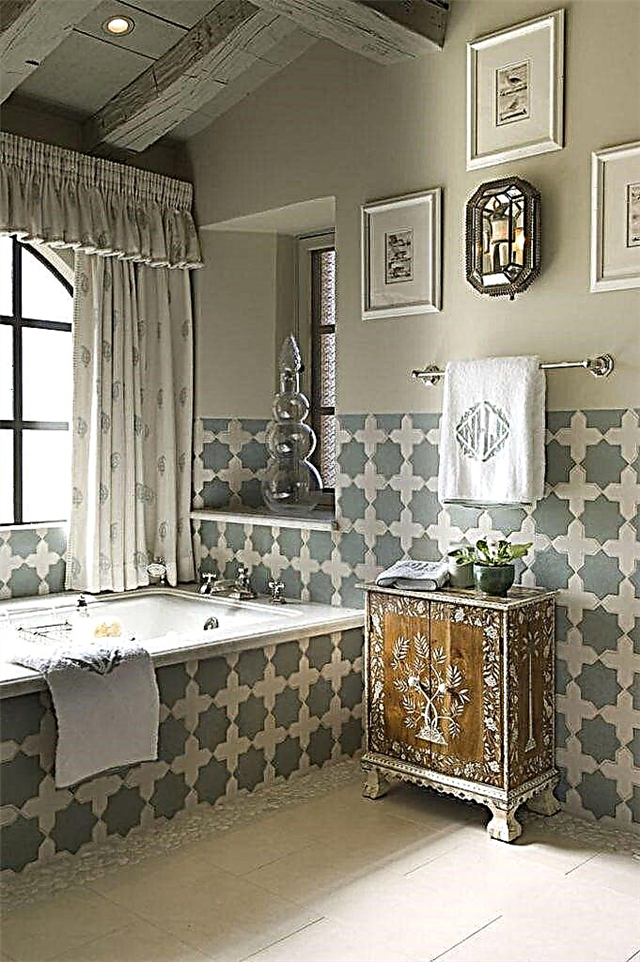
Of the main characteristics of the Moroccan style: large sofas and windows, the use of large curtains and large arches. Another important element of the interior is a special tile, which has become, in its way, the hallmark of the style.
Moroccan style tile

Moroccan tile is something special. The manufacture of this tile is the observance of old traditions, and often - it is a wonderful handmade work. Oriental patterns and flowers enliven any space and surprise guests with their variegated filigree contours. There is an opinion that such a mosaic is quietly whispering oriental tales in your ear, but this is a bit inaccurate :) Such a tile is often similar to a mosaic, especially when using bright colors, but its versatility allows it to be used in many rooms, so you can often notice the use of tiles in Moroccan style in the living room, bedroom or kitchen.
Moroccan-style kitchen decoration

Most often, tiles are used for the floor or to design the space between the upper and lower parts of the kitchen. Of the features of selecting tiles for the kitchen, it should be noted that the wear resistance of the material must be taken into account, and when using expensive tiles, think about how to better preserve it. Do not use too light tiles, as they will quickly get dirty. A good option would be to finish the space around the slab in the form of a mosaic using black.
Moroccan ceramic tiles in the bathroom

Moroccan-style tiles in the bathroom blend best with exquisite bathrooms and matching large mirrors. Often used square tiles, but with a characteristic pattern that sets the style. Photos of bathroom tiles can be found below and choose the one you need. The places that are most often decorated using tiles in the bathroom: floor, frontal wall opposite the entrance, space near the sink. With its help, you can visually separate the bathroom from the toilet in the combined bathrooms.
Moroccan-style bedroom or living room design

Of course, tile in the bedroom is a rather rare occurrence, but it also cannot be completely ruled out. First of all, this is due to the quality and variety of Moroccan tiles. It is used primarily for decorating small pieces of wall near coffee tables or columns. In some cases, you can see Moroccan tiles to decorate the floor of the balcony.
Distinctive features of the finishing material
Moroccan-style tiles are easily recognizable by their decorative design: complex patterns with floral motifs and colorful ornaments with geometric outlines indicate that decorators use the basis of the oriental direction in design. The facing material for a house or apartment in the Moroccan style is easy to choose without the help of an interior stylist, as the dynamic design with multicolor paints involuntarily captivates the eye with a unique decor:
- the appearance of the diverse vegetation depicted on the tile surface compensates for the lack of scarce African flora, creating a feeling of freshness and coolness in houses where the inhabitants of Morocco manage to take a break from the year-round heat and heat,

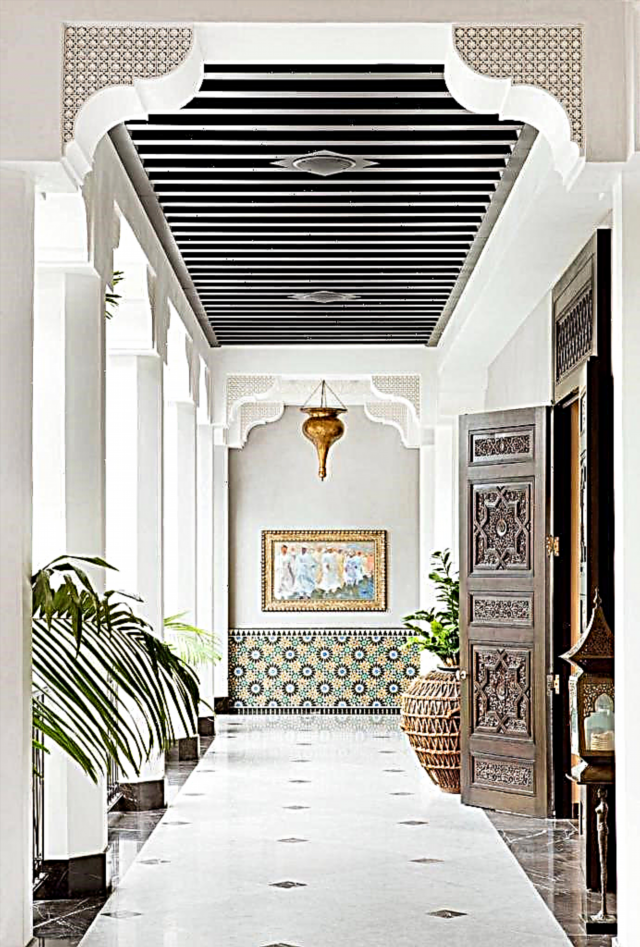



- expressive color schemes with the dominance of different gradations of gold, red and blue - the basic decor of the facing materials used to decorate the walls, floors and ceilings of the bathroom, where the aesthetics of this fabulously beautiful interior design trend dominate,
- multicolored placers of ceramic mosaics illustrating floral motifs and geometric ornaments are an indispensable element of home decoration in the Moroccan style.

Moroccan-style modern bathroom with tiles

Solid Moroccan-style tiles on one of the kitchen walls
Representatives of the Islamic faith living in Morocco strictly abide by the main rule of the ban on decorating the house with animal and human shapes. Silhouettes of inspired characters depicted on ceramic panels welcome the colonial style, but the aesthetics of the Moroccan style are categorically not acceptable.
The rich color scheme, prevailing in the decor of the decoration elements typical of this interior genre, expressively looks on a neutral light background: white, light blue, sand or pearl. A peculiar game in the contrast of bright patterns and the monophonic basis of the tile sets the dynamics of colorfully designed interiors, mesmerizing with magical mystery and bohemian luxury.
In a house that uses colorfully decorated Moroccan-style tiles for the bathroom or kitchen, the summer atmosphere will reign all year round, radiating heat from solar paints, which the post-Soviet residents sorely lack in the cold season.






Advice! Tiles in the Moroccan style are characterized by bright decor with a predominance of natural tones, painting with multi-element ornaments that embody the beauty of the flora of the North African country.
The use of decoration material with curly outlines and geometric ornaments is encouraged. Therefore, it will organically look in this oriental style and modern areas of interior design, since the geometric configuration of furnishings and cladding is now in fashion.

Moroccan-style ceramic tiles in the living room fireplace

Mediterranean style kitchen studio with Moroccan tiles on the floor

Decorating the kitchen apron with bright ceramic tiles
Advantageous features of the tile
Zelidzh - a unique ceramic tile, brightly painted with oriental motifs. Facing rooms using this man-made decoration element symbolizes the high status and prosperity of homeowners, since genuine Moroccan-style bathroom tiles can be bought at a high cost in a single copy.
Zelidge is hand-made by talented artisans with the gift of a painter. In addition, only craftsmen who for 17 years have studied ancient traditions, mastered the basics of the art of creating and painting original clay tiles can be awarded the title of master in creating zelij.



Masters are able to master the sophisticated technology of zelidzh production as a result of long and painstaking work on the creation of ceramic masterpieces:
- Work on developing the shape of the tile and creating the design can last for six months, since multi-element ornaments and patterns require symmetry, the right selection of color combinations, and mathematical calculations regarding the configuration of small clay products. It can have all kinds of shapes: square, hexagon, triangle, rhombus or any other geometric shape.
- After creating the template, taking into account the individual requirements of designers or any other customers, clay blanks are created.


The bath area is beautifully decorated with pink and white zealge tiles
Moroccan-style oriental patio design
The size of the zelij mosaic varies from 3-6 cm. Ceramic panels with ethnic motifs from masters from Morocco can consist of a million pieces that are assembled according to the patterns for a long time. In limited batches, European countries from the African continent receive tiles in the Moroccan style. Buy genuine sReligion is only possible with official representatives working with North African craftsmen.
For many centuries, this unique tile, decorated with colorful oriental motifs that embody Islamic culture, has been used for exterior and interior decoration of various architectural structures and houses. The rich decor of walls, columns, floors, vaults, stairs and other parts of the premises eloquently testifies to the respect for exotic lovers of this particular ethnic direction.


The result of lining with tiles made in the technique of greening will exceed all the expectations of true connoisseurs of original finishing materials. Man-made works of art made of ceramics with oriental national ornaments will turn your bathroom into a real hammam, where the colors of sun-burnt Morocco dominate the burning eyes.
Moroccan-style tiles in the kitchen or in the ablution room will definitely become the center of attraction of universal attention, since the mysterious oriental motifs emitting a pearly shine will tirelessly delight in the impeccable execution of the decor and the filigree selection of each element of a multi-component mosaic picture.
Advice! None of the high-tech equipment is capable of perfectly accurately copying the appearance of zelidge, because genuine cladding material is made and executed manually by venerable specialists for a long time. Therefore, ordering an original panel or tile made using the zelig technique is necessary only from local masters from Morocco.

Variations of color schemes of tiles in the Moroccan style
Colorful oriental motifs using variegated colors of the color palette are mainly used for decoration of ceramic tiles. Moroccan style has incorporated all the most vivid natural tones found in the environment:
Green tile in the interior of the kitchen
- Orange ,
- purple,
- ocher
- red carmine
- lilac
- malachite,
- turquoise
- ruby,
- ultramarine
- emerald.

The excessive brightness of the color range of the tiles used to clad the inner shell of the housing can create a feeling of discomfort and fatigue from a saturated color scheme. Therefore, it is necessary to proportionately combine the brightly decorated accent walls in the house with the surrounding objects of neutral color.
For example, to combine the wall decoration with bee honeycomb tiles, decorated with oriental ornaments with flashy tones, with the design of the ceiling and floor with large slabs of porcelain stoneware in snow-white or sand tones with subtle ethnic patterns. As a link, faceting of parts of the room can be made with a frieze decorated with tones found on the motley wall cladding and neutral decoration of the upper and lower parts of the room.
Multi-colored Moroccan tiles will beautifully decorate the wall in the bathroom
Fusion style bathroom with interesting ceramic tiles on the wall
An important task of creating a harmonious picture of the interior in the Moroccan style is the ability to combine warm and cold tones when choosing the best option for the interior decoration of the room. In the homes of the inhabitants of this country, interiors are often depicted with an oasis on the walls with ceramic finishes that focus on themselves with an abundance of greenery, a pond and boundless heavenly blue.
Therefore, it’s important to decorate the kitchen apron or the center of the interior composition in the bathroom of a mosaic panel depicting an uninhabited island located in the middle of the ocean or lagoon surrounded by desert.
Unusually in the interiors, executed in the spirit of the East, the symbiosis of typical stylistic directions looks:
White and Brown Moroccan Bathtub Combination
Mediterranean-style bathroom with white and blue ceramic tiles
Large mosaic of ceramic tiles in the living room
For the interpretation of each direction of design, you can choose a specific component of the interior composition. To highlight the Arabic style, you need to pick up colorful textile items sewn from natural fabrics. A characteristic feature of the Asian interior genre can be floor tiles with the image of sakura blossoming. Moroccan style can be easily recognized by the ligature of densely intertwined ornaments with colorful colors.
The combination of ethnic motifs - damask patterns, ikat, floral and geometric ornaments will create an atmosphere of bewitching with magical beauty in the house, visually reminiscent of the fabulous life of the sheikhs and the beautiful Scheherazade.
Advice! To create a magical atmosphere in the house, it is enough to use Moroccan-style tiles, which are perfect for creating an imitation of a paradise at the edge of the world. The effect of perspective can be produced on the viewer of the interior composition through the use of small-sized ceramic mosaic frisize. The interweaving of ornate patterns or combinations of geometric ornaments is a winning option for home decoration, requiring visual expansion of a cramped space or modeling of the layout.
Modern Mediterranean style interior with light tiled flooring.
Stylish black and white kitchen with ceramic tiles on the floor
Key Features
Morocco is a distinctive eastern country. Of course, a state with a very ancient history simply has to have its own style. Moroccan style belong to the group of ethnic, it is characterized by the use of antique objects in the interior and the exclusion of modern decorative elements. Perhaps this is both a plus and a disadvantage in this area.

When decorating a house in such a style, it can be difficult to pick up furniture, decide on the design of windows, walls and ceilings, because in everything you need to adhere to unity. In the first place in such an interior is the luxury of the East, and only after that - functionality and practicality.
The color scheme of the Moroccan interior knows no bounds. Here you can safely combine warm shades with cold tones, alternate elaborate patterns with straight strict lines, apply various materials - glass, wood, leather, ceramics.

Ceramics is the hallmark of this style. Most successfully, it is implemented in tiled cladding. In the Moroccan style, tile is not just appropriate, it is almost the main attribute of space decoration. At the same time, it goes well with other facing materials, including wallpaper.
This style is characterized by the use of small tiles of 4x4, 3x3 and 2x2 cm.


It is she who is his distinctive and recognizable feature throughout the world. The cladding necessarily has a textured decoration with all kinds of oriental ornaments and is laid out with characteristic patterns.
Tiles in this style are used for facing walls, floors, ceilings, both whole and fragmentary.
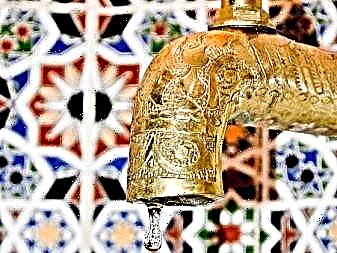

The Moroccan-style ceramic cladding is called Zullige or Zelidge, as Europeans say. These are small elements in the form of squares, rhombuses, stars, rectangles. True craftsmen make real Moroccan tiles by hand, applying a special bright glaze at the end. From such fragments, you can create a truly unique mosaic ornament by choosing elements of various colors, shapes and sizes. There are no canons within the style itself, everyone can create a decor at their discretion.
A bit of history
Moroccan style has incorporated all the flavor of the East. This interior is combined with the aroma of oriental spices, real coffee and tart tobacco. An important role in this style is played by tile, which surprises with its unusualness, unique appearance and amazing aesthetics. From ancient times, such material was used to lay out halls in the rich houses of the East, and then European aristocrats also adopted these trends.
True connoisseurs of oriental art tiled with such tiles not only bathrooms, but also other rooms, regardless of their purpose.

And today, working with such ceramics, craftsmen are guided by ancient manufacturing techniques. It is noteworthy that the first creators of the tile studied this difficult matter until the age of 8, learning to correctly combine mosaic elements and doing hand painting. The work was lengthy and requiring a lot of effort, because the tile was valued very expensive and was considered exclusive. Only very wealthy people could afford it.


In the past, Moroccan tiles were produced exclusively in single copies, as they were painted by hand, and analogues simply did not exist. To create, special clay and colorful natural enamel were used. Masters made tiles of various shapes and sizes at the request of wealthy customers.
The creation of Moroccan tiles consisted of several stages.
- Before starting work, the master made several clay blanks.
- After he applied various shades and colors to them in the form of fancy ornaments.
- Then the tile was covered with enamel, and it was left for some time to fix the top layer.
- At the end, the product was given the desired shape, trimming the excess parts.
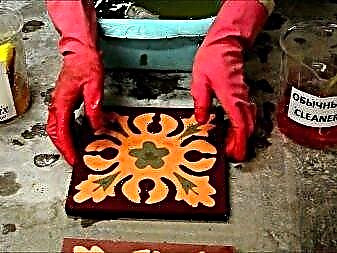

The finished tile was laid out on the floor and walls according to a previously invented pattern. The material was attached to the surface using clay mortar.
Today, the market presents both hand-made tiles and modern industrial options. Modern Moroccan tiles combine not only shapes, textures and shades, but also various ethnic interweaving: the cultural heritage of African, Arab and Berber ancestors. An important role in the modern idea of this style was played by Europeans. Having fallen in love with this bright, saturated interior, they brought some moderation and conciseness into it.
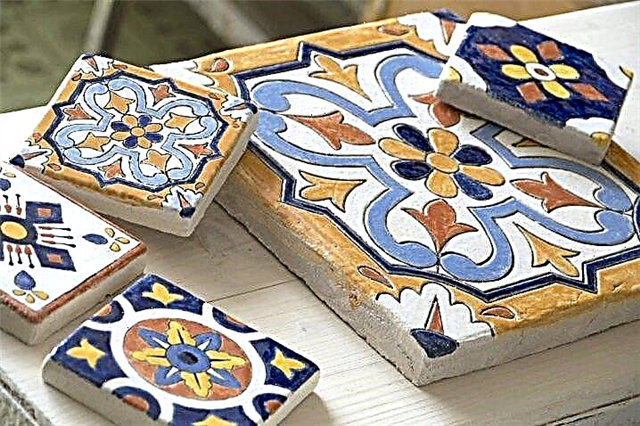
Color variety
Moroccan style is characterized by the use of non-standard color solutions that cannot be seen in other areas of design. This style is characterized by a mixture of warm and cold shades, which is complemented by ultramarine and emerald patches. At the same time, saturated red and deep black can become accentuators.
The basic rule is the creation of a unique play of color, calling for action and activity. Tiles in this style give the interior an impulsive character typical of eastern countries.
The basis, as a rule, is a neutral palette: white, brown, all shades of yellow, bronze, the color of the umber. For accent spots, bright colors of blue and emerald colors are used, as well as purple, purple, scarlet and black.
It is noteworthy that with such a riot of colors, visual perception is not overloaded. The interior does not tire the look, but simply creates the impression of a positive, pleasant space in rich colors. Today, the Portuguese or Spanish collections are most popular.
Design Ideas
Moroccan-style tiles are one of the most recognizable in decorative art. Floral motifs, elaborate patterns, unrealistic, almost cosmic abstractions, colorful ornaments, geometric shapes - all this sets a certain mood and tone for this oriental direction in the field of interior design.
Mosaic small-sized constructions bring perspective effect to the interior, and the combination of strict geometry and ornate ornaments is a win-win option for decorating an apartment that needs visual expansion of the premises.


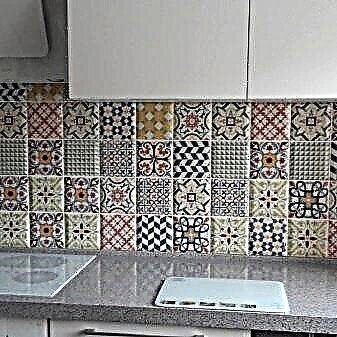
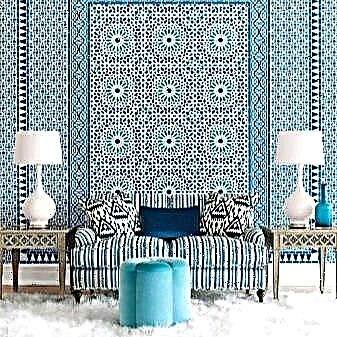
In order not to overload the space, you can use a tile of exotic design and as an imitation of a "paradise", highlighting individual zones.
Kitchen
As a rule, in the kitchen, tiles in this style are tiled with the floor and apron of the working area. The main requirement for the material - it must have wear resistance and strength. Do not use too light tones in the decoration, they are impractical. Unusual and interesting in the kitchen interior looks Moroccan tiles in black and deep blue, the elements of which create a mosaic with the addition of light fragments.

This design looks especially successful in the working area above the stove.


Bathroom
In the bathroom, this material blends perfectly with large mirrors. In such rooms, very small square tiles are often laid, creating a typical oriental mosaic pattern from separate fragments. Good places for using such a tile in the bathroom are the areas near the sink, on the wall opposite the front door, on the floor, around the perimeter.
In the interior of the bathroom in the Moroccan style, an arch is an important attribute. Arched spaces make horseshoe-shaped, lancet, narrow or, conversely, wide. You can create a visual arch in a bathroom devoid of free space by laying tiles accordingly.
Bedroom and living room
Tile in the bedroom or living room is not the most popular solution, from this a similar design looks even more unusual. In rooms with Moroccan tiles, fragments of the wall can be decorated, zoning the space. For example, you can separate the rest area from the dining area.
Also, sometimes Moroccan tiles are used for facing a balcony or loggia.
See how to make tiles in Morocco in the video below.

